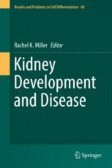Search
Search Results
-
Epithelial-Mesenchymal Transition (EMT) and Prostate Cancer
Typically the normal epithelial cells are a single layer, held tightly by adherent proteins that prevent the mobilization of the cells from the...
-
Introductory review: periostin—gene and protein structure
Although many studies have described the role of periostin in various diseases, the function of the periostin protein structures derived from...

-
Bone morphogenetic protein 2 promotes human trophoblast cell invasion by upregulating N-cadherin via non-canonical SMAD2/3 signaling
BMP2 expression is spatiotemporally correlated with embryo implantation and is crucial for endometrial decidualization and fertility in mice. BMP2...

-
Muscleblind-like 1 is required for normal heart valve development in vivo
BackgroundDevelopment of the valves and septa of the heart depends on the formation and remodeling of the endocardial cushions in the...

-
The p53 family members have distinct roles during mammalian embryonic development
The p53 tumor suppressor is a member of a multi-protein family, including the p63 and p73 transcription factors. These proteins can bind to the same...

-
BMP-SMAD signalling output is highly regionalized in cardiovascular and lymphatic endothelial networks
BackgroundBone morphogenetic protein (BMP) signalling has emerged as a fundamental pathway in endothelial cell biology and deregulation of this...

-

-
Depletion of polycomb repressive complex 2 core component EED impairs fetal hematopoiesis
Polycomb repressive complex 2 (PRC2), a H3K27me3 methyltransferase complex, promotes the development of many organs by silencing ectopic...

-
Genome-wide Twist1 occupancy in endocardial cushion cells, embryonic limb buds, and peripheral nerve sheath tumor cells
BackgroundThe basic helix-loop-helix transcription factor Twist1 has well-documented roles in progenitor populations of the develo** embryo,...

-
Epithelial to Mesenchymal Transition (EMT) and Endothelial to Mesenchymal Transition (EndMT): Role and Implications in Kidney Fibrosis
Tubulointerstitial injury is one of the hallmarks of renal disease. In particular, interstitial fibrosis has a prominent role in the development and...
-
Human fetal and adult epicardial-derived cells: a novel model to study their activation
BackgroundThe epicardium, a cell layer covering the heart, plays an important role during cardiogenesis providing cardiovascular cell types and...

-
Cardiomyocytes: Function and Regeneration
In vertebrate embryonic development, the heart is the first organ to shape and start functioning. In higher developed vertebrates, it is organized by...
-
Meis2 is essential for cranial and cardiac neural crest development
BackgroundTALE-class homeodomain transcription factors Meis and Pbx play important roles in formation of the embryonic brain, eye, heart, cartilage...

-
Blood flow mechanics in cardiovascular development
Hemodynamic forces are fundamental to development. Indeed, much of cardiovascular morphogenesis reflects a two-way interaction between mechanical...

-
GATA-dependent transcriptional and epigenetic control of cardiac lineage specification and differentiation
Heart progenitor cells differentiate into various cell types including pacemaker and working cardiomyocytes. Cell-type specific gene expression is...

-
Embryological Origin of Valve Progenitor Cells
The cardiac valves are required for unidirectional blood flow, preventing backflow during diastole. The adult mammalian heart includes four valves:...
-
The pattern of congenital heart defects arising from reduced Tbx5 expression is altered in a Down syndrome mouse model
BackgroundNearly half of all individuals with Down Syndrome (DS) have some type of congenital heart defect (CHD), suggesting that DS sensitizes to...

-
Diverse Cellular Origins of Cardiac Fibroblasts
Cardiac fibroblasts synthesize and remodel the extracellular matrix (ECM) Extracellular matrix (ECM) of the heart and...
-
Human Induced Pluripotent Stem Cell-Derived Cardiomyocytes as a Model for Heart Development and Congenital Heart Disease
Congenital heart disease (CHD) remains a significant health problem, with a growing population of survivors with chronic disease. Despite intense...

-
Analysis of microRNA Microarrays in Cardiogenesis
microRNAs are a subclass of noncoding RNAs which have been demonstrated to play pivotal roles in multiple cellular mechanisms. microRNAs are small...
